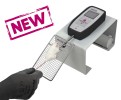Authors
Menzies FM, Garcia-Arencibia M, Imarisio S, o'sullivan NC, Ricketts T, Kent BA, Rao MV, Lam W, Green-Thompson ZW, Nixon RA, Saksida LM, Bussey TJ, o'kane CJ, Rubinsztein DC
Lab
Cambridge Institute for Medical Research, University of Cambridge School of Clinical Medicine, Cambridge, UK
Journal
Cell Death Differ.
Abstract
Over recent years, accumulated evidence suggests that autophagy induction is protective in animal models of a number of neurodegenerative diseases. Intense research in the field has elucidated different pathways through which autophagy can be upregulated and it is important to establish how modulation of these pathways impacts upon disease progression in vivo and therefore which, if any, may have further therapeutic relevance. In addition, it is important to understand how alterations in these target pathways may affect normal physiology when constitutively modulated over a long time period, as would be required for treatment of neurodegenerative diseases. Here we evaluate the potential protective effect of downregulation of calpains. We demonstrate, in Drosophila, that calpain knockdown protects against the aggregation and toxicity of proteins, like mutant huntingtin, in an autophagy-dependent fashion. Furthermore, we demonstrate that, overexpression of the calpain inhibitor, calpastatin, increases autophagosome levels and is protective in a mouse model of Huntington's disease, improving motor signs and delaying the onset of tremors. Importantly, long-term inhibition of calpains did not result in any overt deleterious phenotypes in mice. Thus, calpain inhibition, or activation of autophagy pathways downstream of calpains, may be suitable therapeutic targets for diseases like Huntington's disease.
BIOSEB Instruments Used:
Grip strength test (BIO-GS3)

 Douleur - Allodynie/Hyperalgésie Thermique
Douleur - Allodynie/Hyperalgésie Thermique Douleur - Spontanée - Déficit de Posture
Douleur - Spontanée - Déficit de Posture Douleur - Allodynie/Hyperalgésie Mécanique
Douleur - Allodynie/Hyperalgésie Mécanique Apprentissage/Mémoire - Attention - Addiction
Apprentissage/Mémoire - Attention - Addiction Physiologie & Recherche Respiratoire
Physiologie & Recherche Respiratoire
 Douleur
Douleur Système Nerveux Central (SNC)
Système Nerveux Central (SNC)  Neurodégénérescence
Neurodégénérescence Système sensoriel
Système sensoriel Système moteur
Système moteur Troubles de l'humeur
Troubles de l'humeur Autres pathologies
Autres pathologies Système musculaire
Système musculaire Articulations
Articulations Métabolisme
Métabolisme Thématiques transversales
Thématiques transversales SFN2024: Venez rencontrer notre équipe sur le stand 876 à Chicago
SFN2024: Venez rencontrer notre équipe sur le stand 876 à Chicago 